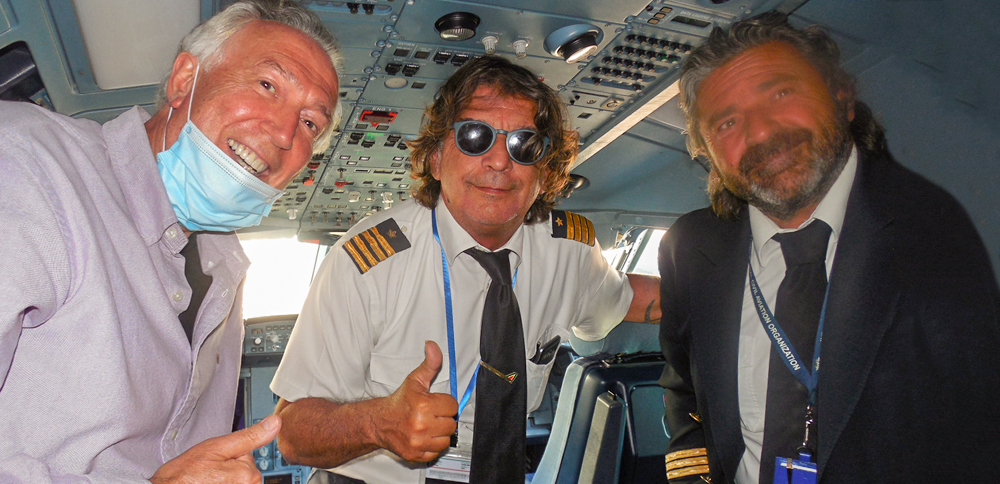By Dom Serafini
I dislike airports under normal circumstances, in particular: JFK and LGA (both in New York City), EWR (Newark, New Jersey), ATL (Atlanta), the new Delta Terminal at LAX (Los Angeles), CDG (Paris), AMS (Schiphol, Amsterdam), MXP (Malpensa, Milan), FCO (Fiumicino, Rome), and LHR (London, Heathrow). But after having been stuck at home in New York City since February, it was even nice to go to JFK for an Alitalia flight to Rome, Italy.
The eight-hour flight wasn’t easy, though. The experience was taxing, and it required lots of work, tons of preparation, and loads of stamina.
Since the Alitalia Service Center couldn’t be reached by phone so that I could change my seat, I arrived at Terminal 1 (T1) of JFK very early — 2:30 p.m. for a 5:05 p.m. flight. Fortunately, a check-in attendant at the counter was able to switch me from a regular seat to an emergency aisle seat.
The Alitalia plane, an Airbus 330, had arrived in New York the day before, so that there would be time to thoroughly sanitize it. Masks were mandatory throughout the flight.
Before accessing JFK’s check-in window, a guard took travelers’ temperatures (mine was 94.3 degrees F), and registered it on the declaration forms that passengers were given wherein they had to pledge to self-quarantine for 14 days upon their arrival at their destinations in Italy. Only passengers could enter T1 (no visitors) and only those with E.U. passports could purchase plane tickets. Non-E.U. citizens had to have special, non-tourist-related reasons or be in transit to non-E.U. countries.
Most luggage had to be checked in. Only briefcases and handbags were allowed onboard and they couldn’t be stowed in the overhead bins (this requirement will soon be removed). JFK’s T1 boarding area looked like a Soviet-era supermarket, but despite the rather spartan visual, it was functional, with a couple of food stands open. The Alitalia lounge, however, was closed.
Walking through the plane while in flight, I realized that this time around, it was better to be seated in the main cabin, which allowed for an empty seat between all non-related passengers. The business and first-class areas were smaller and full of people unable to maintain social distance.
Only one meal was served during the flight and only bottled water was offered. The lavatory area was problematic due to the large number of elderly people on board who were returning to Albania (24 boarded in wheelchairs) via a connection in Rome. Even though they were diligent about wearing their masks, they tended to congregate and since they only spoke Albanian, communication was difficult. In any case, it’s more hygienic to use the lavatory while wearing plastic gloves and after sanitizing one’s hands with liquid gel.
Just before disembarking I was invited to visit the cockpit by the plane’s captain, whom I had met last November during an event in Washington, D.C., to take the commemorative photo (above).
Upon landing, passengers were required to disembark three rows at a time. Before passport control, passengers had to fill out another declaration notice, which was left with the border police, and our temperatures were taken once again by thermo scanners, which were not clearly visible to passersby.
After collecting my luggage, I exited the terminal, but before heading toward the car rental area (passengers were prohibited from using public transit; they had to use taxis, be picked up by car by family members, or rent a car), I stopped at one of the airport’s bars for freshly-squeezed orange juice and a cappuccino. I kept my mask on while ordering and sanitized my hands before and afterward with sanitizer from a gel dispenser by the bar counter.
After a three-hour drive through the Apennine Mountains, I arrived at my residence in the seaside resort town of Giulianova, which is located exactly across from Rome, on the east coast.
Before leaving New York, I notified the local Italian health authority via email of my imminent arrival so that I could get specific instructions as to how to quarantine correctly (the U.S. is still among the special COVID-19 monitored countries, as is Brazil). After arrival at my destination, I restricted my outings to early in the morning when the streets were semi-deserted, and I’ve been monitoring my temperature twice daily.
Life in Giulianova, which resembles Cannes (but is much more affordable, and has a wider beach), is a perfect example of the “new normal” we’ve been thrust into. Most people wear masks in public places and practice social distancing. Businesses, bars, restaurants, and stores are open, though. And at the beach, an attendant measures visitors’ temperatures before they can head out onto the sand, and sun umbrellas are placed far apart.
Photo l. to r.: This journalist, Captain Giampaolo Guerra, and the co-pilot, Ivan Viglietti.


What a journey!